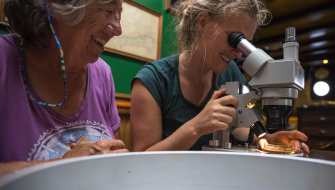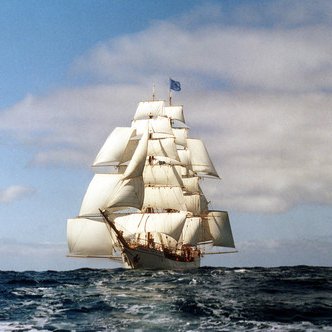Sargasso

Bark Europa has been sailing well east of the area of the Atlantic Ocean that is conventionally known as the Sargasso Sea, but several days have found us surrounded by yellow clumps of floating plants (technically an algae, not a plant) which is known as Sargasso, or Sargasso Weed. On a couple of occasions we have collected some of the plants with a trawl.
I was astounded to find that each basketball-sized clump of feathery plant contains a complex ecosystem where organisms are born, breed and live their entire lives. We found crabs the size of my fingernail, coin-sized fish, centimeter-long shrimp and a multitude of other tiny creatures barely visible to the eye, darting about in our buckets. In contrast, we have also been trawling the open ocean as part of a “plastic in the oceans” project and, in these trawls, we find only a few juvenile flying fish, some ocean-adapted insects called Sea Skaters and tiny, blue copepods.
To help us explore this tiny undersea world of the Sargasso, we placed some of the creatures we found under a microscope, and an astonishing level of detail exploded before us. Feathery mouth parts of a crab, silvery green fish scales, the hair-like fringe along the edge of a crab’s claw, reflecting the light like a neon halo. We saw spiral shells the size of pin heads attached to plants, and an unidentified pink tube, with intricate white markings, and a fringe of pink hairs extending in all directions.

To me, the most stunning thing we were able to observe closely, was a cluster of fish eggs that were about to hatch. In their transparent egg cases, we could see their entire bodies, curled tightly inside: eyes, spine, black-spotted white skin. There were several of the fish larvae, already hatched with bulging red bellies. We also saw some that were no longer in their egg sacs, but were still tightly curled and even more that were actually observed hatching under the microscope.
I marvel that these animals, which float on the surface of an ocean 12,000 feet deep, are completely dependent on their floating seaweed home for survival. If one of those tiny crabs were to fall off into the sea, it would die immediately. The two clusters of eggs sacs we found were attached to the plant with very strong, fibrous hairs that were very difficult to tear apart- an insurance policy that the eggs would hatch where they were laid.

As I look out from the ship and see hundreds of these floating clumps of “weed”, I still find it hard to believe that each one is a world in itself, ingeniously populating an otherwise harsh environment. I also learned that some of these clumps may have been floating for one hundred years. Amazing!






